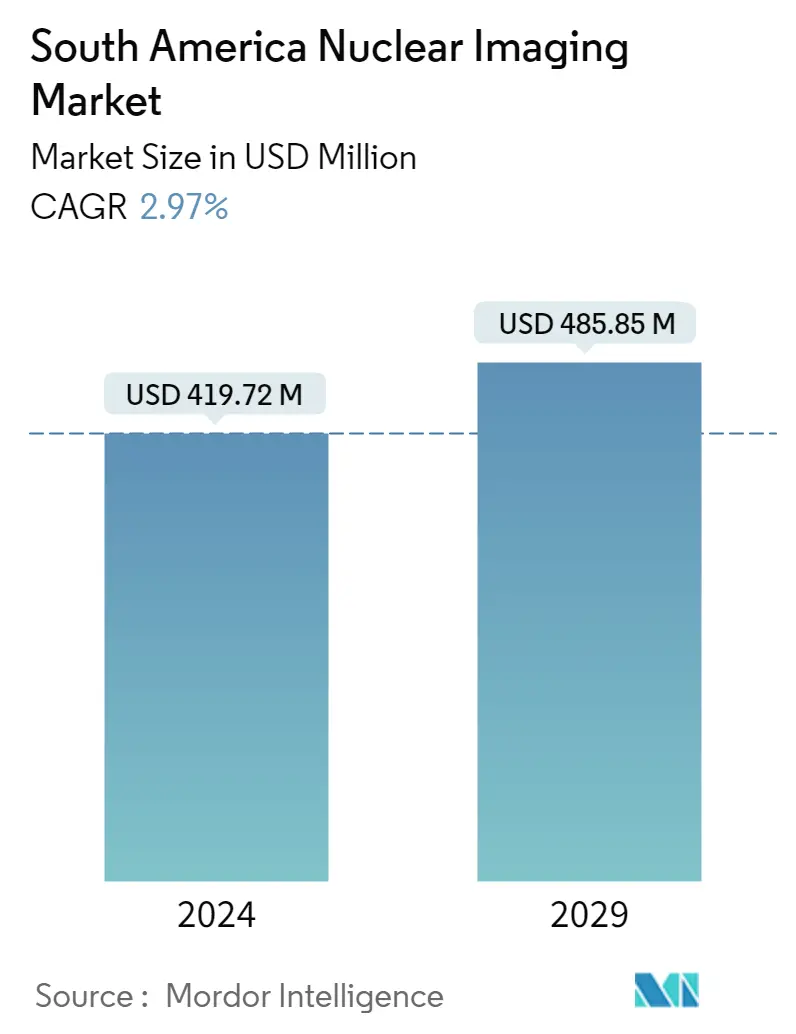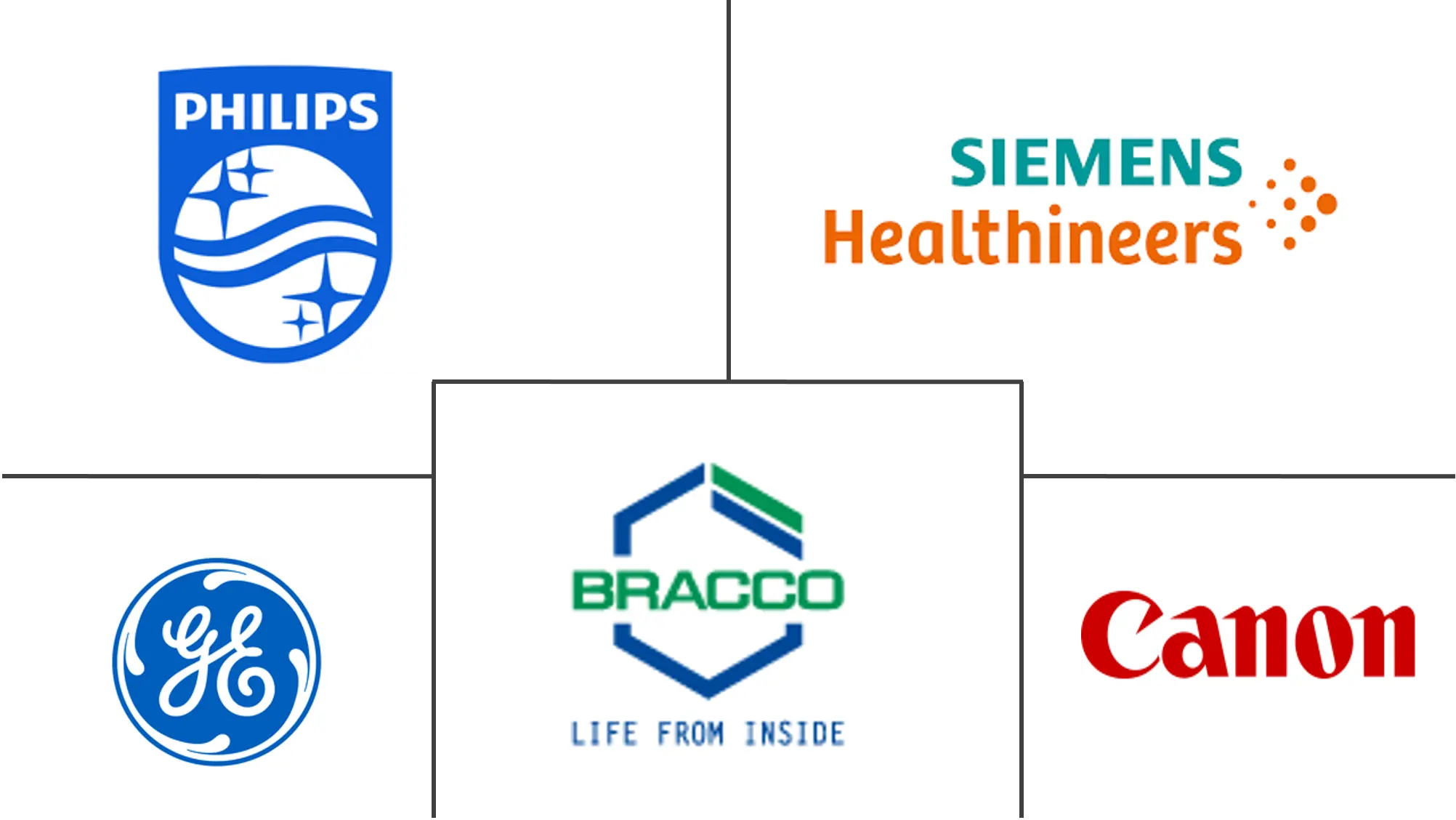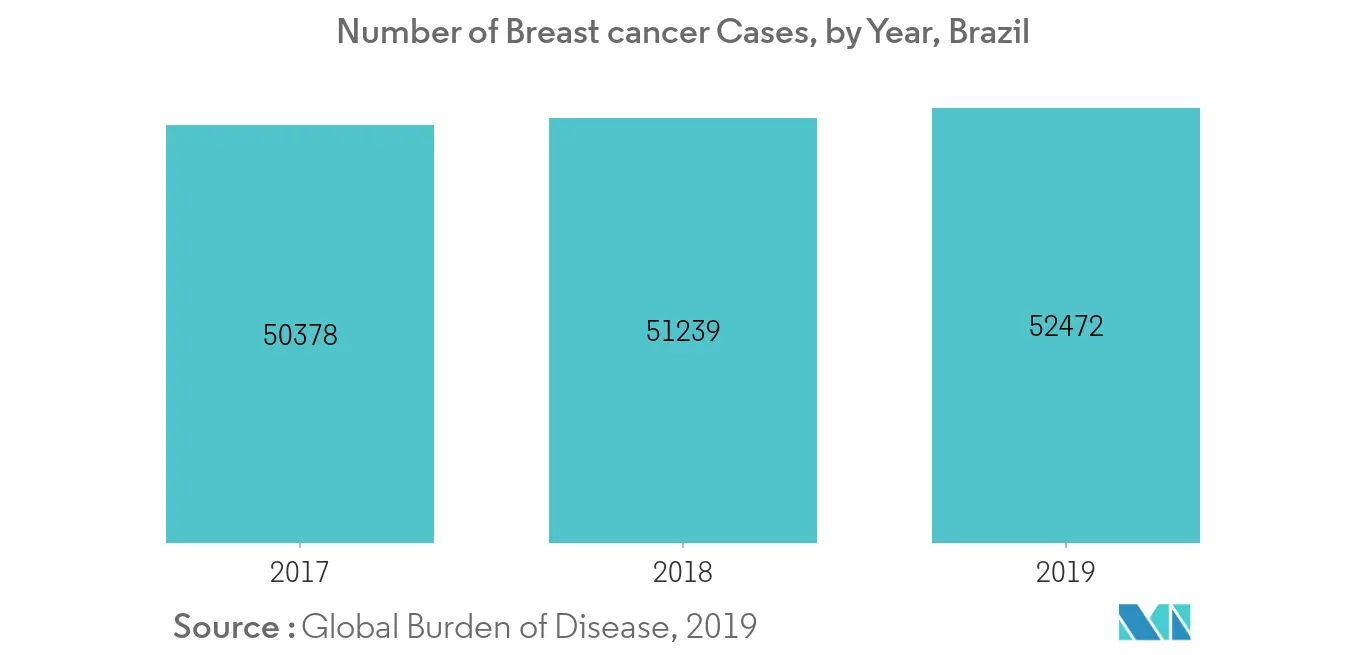South America Nuclear Imaging Market Size

| Study Period | 2019 - 2029 |
| Base Year For Estimation | 2023 |
| Forecast Data Period | 2024 - 2029 |
| Market Size (2024) | USD 419.72 Million |
| Market Size (2029) | USD 485.85 Million |
| CAGR (2024 - 2029) | 2.97 % |
Major Players
*Disclaimer: Major Players sorted in no particular order |
South America Nuclear Imaging Market Analysis
The South America Nuclear Imaging Market size is estimated at USD 419.72 million in 2024, and is expected to reach USD 485.85 million by 2029, growing at a CAGR of 2.97% during the forecast period (2024-2029).
The factors that are propelling the growth of the South American market include increasing diagnostic applications in various diseases, such as cancer and cardiovascular diseases, government support, and a shift from standalone to hybrid modalities, and a rise in prevalence of cancer and cardiac disorders in the region.
Nuclear imaging has applications at various stages of inpatient management processes, such as diagnosis, staging, therapy delivery, and its follow-ups. The primary role of imaging has been diagnostics, but it is increasing slowly for interventional diagnostics and therapeutic uses. However, the lack of proper reimbursement, shortage of the radioisotopes, stringent regulations restraint the market growth in the region.
South America Nuclear Imaging Market Trends
This section covers the major market trends shaping the South America Nuclear Imaging Market according to our research experts:
Oncology is Expected to Have the Highest CAGR in the Forecast Period
The prevalence of various types of cancer in South America has shown a significant rise over the past two decades. The FDG-PET/CT is more sensitive than contrast-enhanced CT scan in the staging of several types of lymphoma or in detecting tumor dissemination in several solid cancers, such as breast cancer, lung cancer, and colon cancer. The introduction of sophisticated software to use PET scan as a biomarker has facilitated new ways to calculate new prognostic markers, such as the metabolic tumor volume (MTV) and the total amount of tumor glycolysis (TLG). The 18F-fluorodeoxyglucose (18F-FDG) has high sensitivity. This technique can be used for the imaging of lung cancer, lymphoma, head and neck tumors, breast cancer, esophageal cancer, colorectal cancer, and urinary tract tumors.
As per the report of the National Institute of Health, in Brazil, cancer is the second most common cause of death, after cardiovascular diseases. In addition according to the estimates of the Globocan 2018, there will be 559,371 new cases of cancer in Brazil. Hence, all the aforementioned factors are expected to drive the growth of the market.

South America Nuclear Imaging Industry Overview
As per the scope of the report, the nuclear imaging market is highly competitive and consists of a few major players. In terms of market share, few of the major players currently dominate the market. Some of the strategies implemented include agreements, collaborative models, business expansion, and product developments.
South America Nuclear Imaging Market Leaders
-
Canon Medical Systems Corporation
-
Bracco Imaging SpA
-
GE Healthcare
-
Koninklijke Philips NV
-
Siemens Healthineers
*Disclaimer: Major Players sorted in no particular order

South America Nuclear Imaging Market Report - Table of Contents
1. INTRODUCTION
- 1.1 Study Deliverables
- 1.2 Study Assumptions
- 1.3 Scope of the Study
2. RESEARCH METHODOLOGY
3. EXECUTIVE SUMMARY
4. MARKET DYNAMICS
- 4.1 Market Overview
-
4.2 Market Drivers
- 4.2.1 Rise in Prevalence of Cancer and Cardiac Disorders
- 4.2.2 Increase in Technological Advancements
-
4.3 Market Restraints
- 4.3.1 Limited Reimbursement and Stringent Regulatory Procedures
-
4.4 Porter's Five Force Analysis
- 4.4.1 Threat of New Entrants
- 4.4.2 Bargaining Power of Buyers/Consumers
- 4.4.3 Bargaining Power of Suppliers
- 4.4.4 Threat of Substitute Products
- 4.4.5 Intensity of Competitive Rivalry
5. MARKET SEGMENTATION
-
5.1 By Product Type
- 5.1.1 Equipment
- 5.1.2 Radioisotope
- 5.1.2.1 SPECT Radioisotopes
- 5.1.2.1.1 Technetium-99m (TC-99m)
- 5.1.2.1.2 Thallium-201 (TI-201)
- 5.1.2.1.3 Gallium (Ga-67)
- 5.1.2.1.4 Iodine (I-123)
- 5.1.2.1.5 Other SPECT Radioisotopes
- 5.1.2.2 PET Radioisotopes
- 5.1.2.2.1 Fluorine-18 (F-18)
- 5.1.2.2.2 Rubidium-82 (RB-82)
- 5.1.2.2.3 Other PET Radioisotopes
-
5.2 By Application
- 5.2.1 SPECT Applications
- 5.2.1.1 Cardiology
- 5.2.1.2 Neurology
- 5.2.1.3 Thyroid
- 5.2.1.4 Other SPECT Applications
- 5.2.2 PET Applications
- 5.2.2.1 Oncology
- 5.2.2.2 Cardiology
- 5.2.2.3 Neurology
- 5.2.2.4 Other PET Applications
-
5.3 Geography
- 5.3.1 South America
- 5.3.1.1 Brazil
- 5.3.1.2 Argentina
- 5.3.1.3 Rest of South America
6. COMPETITIVE LANDSCAPE
-
6.1 Company Profiles
- 6.1.1 Canon Medical Systems Corporation
- 6.1.2 Koninklijke Philips NV
- 6.1.3 GE Healthcare
- 6.1.4 NTP Radioisotopes SOC
- 6.1.5 Bruker Corporation
- 6.1.6 Bracco Imaging SpA
- 6.1.7 Siemens Healthineers
- *List Not Exhaustive
7. MARKET OPPORTUNITIES AND FUTURE TRENDS
** Subject To AvailablitySouth America Nuclear Imaging Industry Segmentation
As per the scope of the report, nuclear medicine imaging procedures are non-invasive, with the exception of intravenous injections, and are usually painless medical tests that help physicians diagnose and evaluate medical conditions. These imaging scans use radioactive materials called radiopharmaceuticals or radiotracers. These radiopharmaceuticals are used in diagnosis and therapeutics. They are small substances that contain a radioactive substance that is used in the treatment of cancer, cardiac, and neurological disorders.
| By Product Type | Equipment | ||
| Radioisotope | SPECT Radioisotopes | Technetium-99m (TC-99m) | |
| Thallium-201 (TI-201) | |||
| Gallium (Ga-67) | |||
| Iodine (I-123) | |||
| Other SPECT Radioisotopes | |||
| Radioisotope | PET Radioisotopes | Fluorine-18 (F-18) | |
| Rubidium-82 (RB-82) | |||
| Other PET Radioisotopes | |||
| By Application | SPECT Applications | Cardiology | |
| Neurology | |||
| Thyroid | |||
| Other SPECT Applications | |||
| By Application | PET Applications | Oncology | |
| Cardiology | |||
| Neurology | |||
| Other PET Applications | |||
| Geography | South America | Brazil | |
| Argentina | |||
| Rest of South America |
South America Nuclear Imaging Market Research FAQs
How big is the South America Nuclear Imaging Market?
The South America Nuclear Imaging Market size is expected to reach USD 419.72 million in 2024 and grow at a CAGR of 2.97% to reach USD 485.85 million by 2029.
What is the current South America Nuclear Imaging Market size?
In 2024, the South America Nuclear Imaging Market size is expected to reach USD 419.72 million.
Who are the key players in South America Nuclear Imaging Market?
Canon Medical Systems Corporation, Bracco Imaging SpA, GE Healthcare, Koninklijke Philips NV and Siemens Healthineers are the major companies operating in the South America Nuclear Imaging Market.
What years does this South America Nuclear Imaging Market cover, and what was the market size in 2023?
In 2023, the South America Nuclear Imaging Market size was estimated at USD 407.61 million. The report covers the South America Nuclear Imaging Market historical market size for years: 2019, 2020, 2021, 2022 and 2023. The report also forecasts the South America Nuclear Imaging Market size for years: 2024, 2025, 2026, 2027, 2028 and 2029.
South America Nuclear Imaging Industry Report
Statistics for the 2024 South America Nuclear Imaging market share, size and revenue growth rate, created by Mordor Intelligence™ Industry Reports. South America Nuclear Imaging analysis includes a market forecast outlook to 2029 and historical overview. Get a sample of this industry analysis as a free report PDF download.



